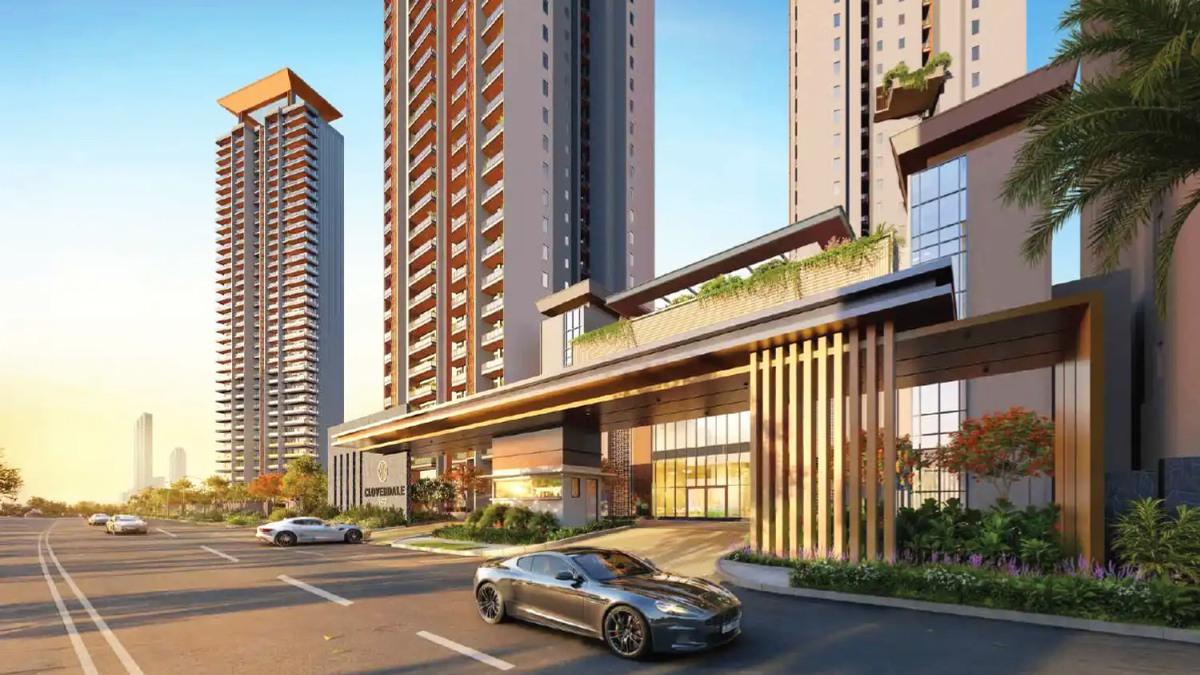Micro-markets like Sohna, Dwarka Expressway, Southern Peripheral Road, and the Yamuna Expressway are transforming the Delhi–NCR real estate landscape, driven by rapid infrastructure growth, new transport corridors, and surging demand for mid-to luxury housing.
Part 1 of a three-part series.

Kindly note the image have only been published for representational purposes. Photograph: Kind courtesy, Signature Global Cloverdales
On a hot Friday afternoon, a construction site for a four-storeyed low-rise building in Sohna, Haryana, 50 kilometres from the national capital, is buzzing.
Around 30 workers are laying the foundations on a tight deadline. The building is part of Daxin Vistas, a 125-acre integrated township by Signature Global, scheduled for completion in 2028.
The project will house 2,408 residential units, in-house malls, and office spaces for industrial and information-technology services under a plotted development model.
For now, it stands alone amid open land dotted with projects, but in three to four years, it will be surrounded by steel and glass towers.
Across India’s largest cities, micro-markets — compact, fast-developing zones shaped by new highways, airports, and Metro lines — are redrawing the real estate map. Around Delhi–National Capital Region (NCR), Mumbai, and Bengaluru, these pockets are seeing rapid infrastructure build-outs, rising prices, and a rush from developers, investors, and end-users to secure early positions.
In Delhi–NCR, three clusters — Southern Peripheral Road (SPR), Dwarka Expressway, and Sohna — are driving much of the residential demand, while the upcoming Jewar Airport is opening a new real estate node on the Yamuna Expressway.

Photograph: Kind courtesy, Signature Global Cloverdales
The spine that built Gurugram
Leading the shift is the 16-km SPR, which runs through Gurugram’s Sectors 68 to 76.
It links Golf Course Road, Sohna Road, and National Highway 48 between Delhi and Jaipur.
There are 23 ongoing projects along SPR, expected to deliver about 11,900 residential units by 2029.
They range from Trump Towers in Sector 69 to Signature Global’s Cloverdale and Titanium SPR in Sector 71, DLF’s three Privana projects in Sectors 76 and 77, and Whiteland’s Aspen in Sector 77.
“This growth is driven by better infrastructure, proximity to corporate hubs, and strong long-term prospects that both end-users and investors see here,” said Pradeep Aggarwal, founder and chairman of Signature Global.
According to PropEquity, Delhi–NCR saw housing sales worth ₹1.5 trillion in 2024, with Gurugram alone contributing over ₹1 trillion.
“Adding to its allure is the proliferation of luxury housing projects backed by robust social infrastructure, such as leading schools, healthcare, and entertainment options,” Sudeep Bhatt, director for strategy at Whiteland Corporation, said.
Luxury housing has gained ground here, supported by schools, hospitals, and entertainment options.
Projects feature high-rise towers, penthouses, spacious apartments, and gated villa communities, many of which sell out within a week of launch.
Developers say new SPR projects typically fall in the ₹17,000–25,000 per square foot (sq ft) range, driven by branded residences and planned communities.
The area also hosts major corporate offices such as American Express and Air India’s training centre, along with 18 commercial developments employing an estimated 75,000 people.
SPR started as an investor-heavy market, but improved livability has drawn families, professionals, micro, small, and medium enterprises, and non-resident Indians looking for long-term options.

Photograph: Kind courtesy, Signature Global Titanium SPR
Dwarka’s value runway
The Dwarka Expressway has emerged as another end-user-focused market. Its 2024 inauguration triggered a sudden spurt in property prices.
The 27.6-km expressway offers direct access to Delhi and the Indira Gandhi International Airport (IGIA), making it a magnet for residential and commercial projects.
Passing through key sectors such as 37D, 103, 105, 106, and 113, prices here have doubled in five years — from ₹9,434 per sq ft in 2020 to ₹18,668 in 2024.
Unlike SPR, the Dwarka Expressway stretch caters to both mid-range and luxury segments. The prices, though, may vary at the two ends of the road.
Premium and luxury projects near Sectors 106, 112, and 113 command ₹24,000–25,000 per sq. ft. These include projects by Godrej, Krisumi, and Westin Residences, which are to be set up in Sector 103.
Mid-range launches closer to Gurugram are priced from ₹10,000 per sq ft upwards. “In recent months, most launches on this side are seeing rates climb to ₹15,000–20,000 per sq. ft,” said Abhinav Joshi, head of research for India, West Asia, and North Africa at CBRE.
PropEquity projects over 18,000 units will be launched and 15,500 absorbed by 2030, pointing to sustained demand.
Farmland to skyline Sohna’s rise is closely tied to the six-lane Gurugram–Sohna elevated road, which has cut travel time to southern Gurugram.
The Sohna–Dausa stretch of the Delhi–Mumbai Industrial Corridor connects the area to Jaipur, Ahmedabad, and Mumbai.

Photograph: Kind courtesy, Signature Global Titanium SPR
Once known for affordable housing, supported by the state’s Deen Dayal Jan Awas Yojna, Sohna is shifting towards mid- and upper-mid-range developments.
Average residential prices jumped 49 per cent between 2022 and mid-2025, from ₹4,700 to ₹6,700 per sq ft, according to Santhosh Kumar, vice-chairman at Anarock.
“A proposed Metro line from Bhondsi to Gurugram railway station is expected to improve last-mile connectivity and reduce reliance on road transport, further enhancing Sohna’s appeal as a promising real estate destination,” Aggarwal said.
Signature Global leads project launches here, followed by Ganga Realty, Central Park Group, MVN Infrastructure, Silverglades, and Ashiana.
Roughly 16,000 units are due over the next three years. Aggarwal said prices are likely to keep climbing as supply catches up with growing buyer and investor interest.

Yamuna’s realty takeoff
On the other side of Delhi, the greenfield international airport at Jewar is reshaping the Yamuna Expressway region.
Much like IGIA’s impact on Gurugram, Jewar is acting as a catalyst for residential, commercial, warehousing, and logistics developments.
“With better connectivity, multimodal logistics potential, and planned integration with expressways and rapid rail, Jewar is drawing large-scale investment in plotted projects, warehousing, electric vehicle manufacturing, and hospitality,” said Gaurav K Singh, chairman of Womeki Group.
Residential prices in the Yamuna Expressway Industrial Development Authority region have risen 51 per cent since 2022, from ₹3,965 to ₹6,000 per sq ft. Combined with infrastructure build-out and lifestyle projects, this has pushed up values by 22–25 per cent since 2021.
“With Jewar Airport nearing operational status and Metro expansion ahead, the outlook remains strong, with annual appreciation of 12–15 per cent expected,” said Ashutosh Kaithwar, head of corporate strategy at Greenbay Golf Village.
Feature Presentation: Rajesh Alva/Rediff




